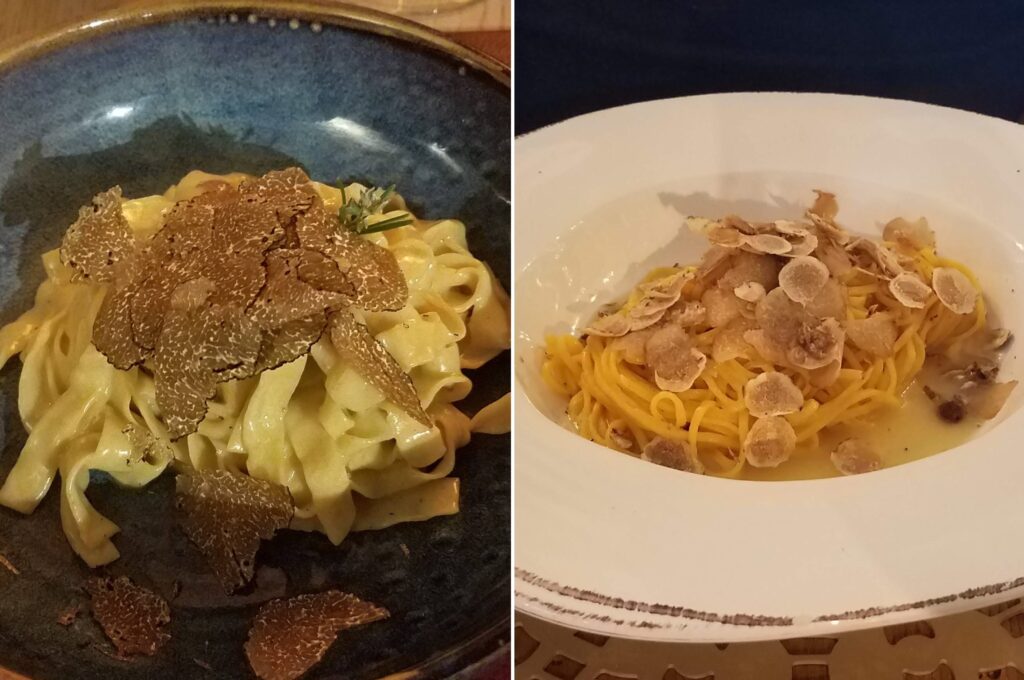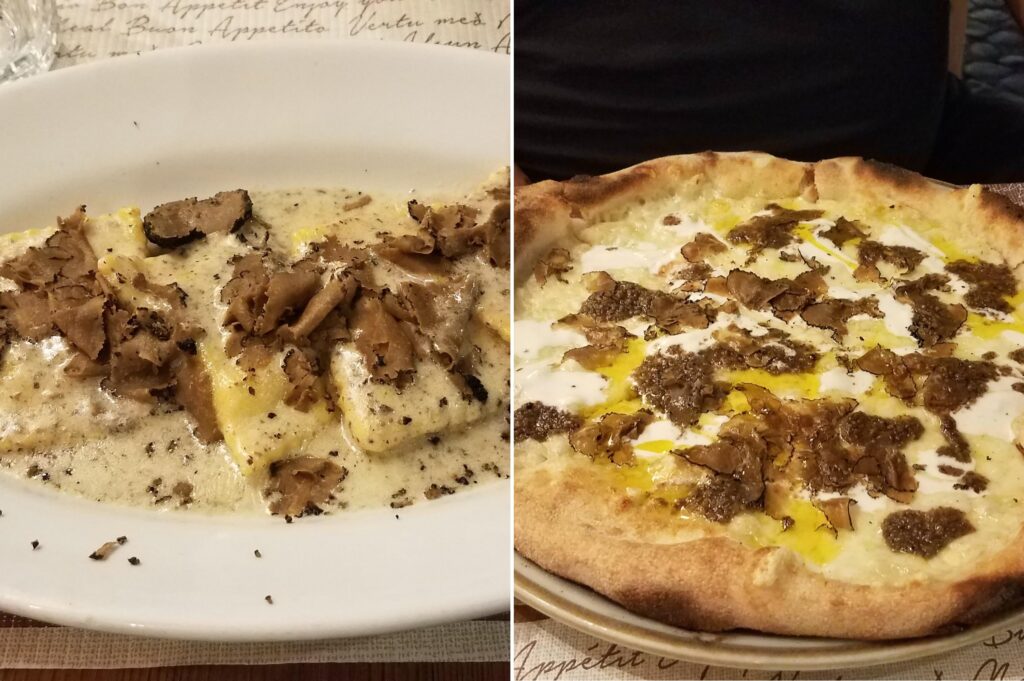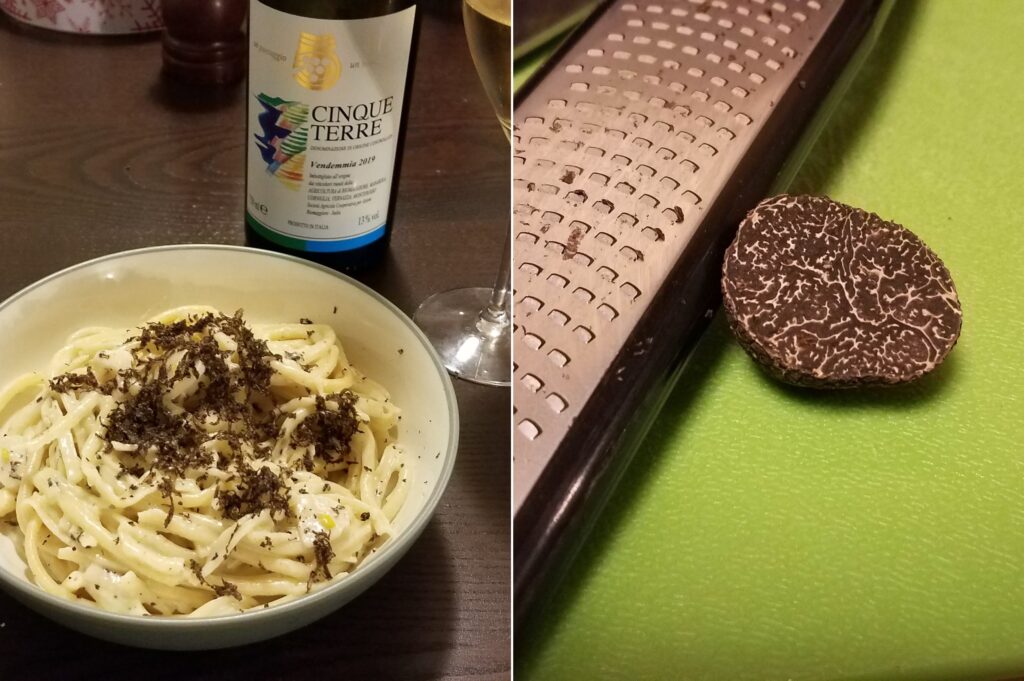It feels a little odd to be writing about something so indulgent and unsustainable on this blog, but I couldn’t help taking a little more time to savor what was likely the most unusual Christmas present I have ever received. I really do try to be as mindful as possible in my decisions about lifestyle, but I have never claimed to be perfect – as you will see on the welcome page of this site. Understanding my impact on the planet is a priority for me, so when I choose to travel somewhere, or buy something, or eat something, I want to (at least) be as informed as possible when making that choice (which is, again, one of the reasons I started this blog in the first place).
This past October, Christian and I went to Italy for two weeks. (He wound up staying on his own for a third, but that’s another story.) While we were there, we had shockingly little garlic (something I fully expected to be plentiful in every dish) but unbelievably generous quantities of truffles on creamy pasta and pizza in Tuscany and Rome. Having only ever eaten truffle oil, truffle salt, and other derivatives before in my life, and having always seen them treated as such a rare delicacy, I couldn’t believe how omnipresent and even commonplace they were in our food.
Background on Truffles
Truffles are a type of fungus that grows symbiotically among the roots of certain trees, such as oak, and are usually found with the use of a truffle dog or a truffle hog (but the hogs, less obedient than the dogs, usually eat the truffles they find). Black truffles – more robust and earthy in flavor than their white counterpart – can actually be cultivated, though the secret of how was not discovered until the 19th century. While France is currently the leader in black truffles, Spain’s production is gaining ground (literally), as government-subsidized cultivation under the EU’s Rural Development Programme is backing the truffle as a major source of revenue and employment.[1]

When we headed to Italy, I knew that truffles were seasonal, but I was surprised to learn that there were more than just the two kinds we knew about: white truffles (Tuber magnatum, in season September through December),[2] and black truffles (Tuber melanosporum, in season November through April [3]). The ones we encountered most frequently on our trip were taxonomically classified as two distinct species, but they are biologically identical, with differences in appearance, flavor, and seasonality largely occurring from environmental factors. These two types are called the “black summer truffle” (Tuber aestivum, May-August) and the “burgundy truffle” (Tuber uncinatum, September-December [4]). Looking back through my copious food photos, what I originally thought were black truffles were all most likely the “burgundy truffle,” based on the calendar. I do wonder if we had the occasional summer truffle as they tapered off and black truffle as they ramped up, but who is to say (other than the restaurant owners)?
The real prize, which we sprung for only once – indeed, only saw on a menu once – was the white truffle. During a super fancy lunch off the beaten path in the Tuscan countryside (what would ultimately be our last Italian lunch together) Christian ordered a white truffle pasta dish, totaling €33 (about $33 at the time). To the restaurant’s credit, they were not stingy with the white truffle, but – for reference – the black truffle equivalent pasta dish on their menu was 10 euro cheaper. The white truffle flavor was much more delicate, meaning that – unsurprisingly – I preferred it, and Christian did not. Later that night, back in Rome (for what would ultimately be our last dinner together on the trip), the cook rained down black truffles on our (exceedingly affordable) ravioli and pizza, making it one of our favorite meals in a trip full of amazing meals.
Experiencing a massive amount of nostalgia for the incredible food we had in Italy, we bought each other relevant ingredients and cooking implements for the upcoming holidays. That much was not surprising. What was surprising was one gift in particular, the centerpiece of Christian’s gifts for me: a black truffle, flown in from France. It arrived a few days before Christmas, and we learned within minutes of opening it that it could not wait – we would need to use it within 2-3 days.[5] All of my Christmas prep was put on hold while I made truffle pasta, truffle pizza, and truffle eggs, cooking real meals in the kitchen for (I hate to admit) one of the first times since Vegan January.[6]
Air Transport
I love cooking, even though I rarely make time for it. Having an incredibly delicious wrench thrown into my Christmas week plans was a wonderful problem to have, and I was not going to waste this precious gift, full well knowing the carbon footprint of food transported by air. The vast majority of our food travels by ship, rail, or road, with only 0.16% traveling by plane – but that little bit that goes by air can have a massive carbon footprint, as much as 50 times greater than if it had traveled by boat.[7] Of course, if your ingredient, such as berries … or truffles, won’t survive a weeks-long journey to your door by boat, the only option is air travel … or to eat locally and seasonally – a legitimate and viable option.

I was curious, though, to figure out the carbon footprint of this small piece of black gold that arrived at my door. I had absolutely no idea what the entire supply chain looked like from farm to table, but I could at least make some assumptions about the air travel component. For example, we know from a food study that the CO2-equivalent emissions resulting from air-based transportation of food is approximately 1.13kg of emissions for every 1000kg of product transported 1km.[8] I knew that my truffle was from France, and that the majority of French truffles are grown in the southeast part of the country.
Looking at global supply chain routes, FedEx (for example) has hubs in or near Paris and New York City.[9] It’s possible that additional flights could have been involved to get my truffle from the farm to Paris and from New York to Pittsburgh, but we can surmise at the very least that it was flown from Paris to New York. Given that distance (5,837km) and the weight of the cardboard, ice pack, and packing material to cradle my delicate little 60g of truffle (all approximately 0.75kg) we can assume that the travel footprint simply by air (not including any requisite ground transportation) was, at a minimum, 5kg CO2e.
To put that number in perspective, my carbon footprint flying direct from JFK to Rome in economy class was 1,715kg CO2e.[10] Having a truffle flown here was a small drop in the bucket, to be sure, but 600kg is apparently the limit of what can be generated by a single person in a year to halt climate change (and the average per person in the EU – notoriously more climate conscious than the US – is 8,400kg).[11] I am aware that multinational organizations, particularly those involved in the proliferation of fossil fuel extraction and use have a much larger part to play in our current climate crisis, but I would be remiss if I didn’t also mention that individual decisions add up, especially if people trying to be responsible also vote for government representatives who share their priorities.

But I digress. In returning to the kitchen and my incredible Christmas present, I will say that it was an challenging but fun couple of days creating some delicious dishes that attempted to rival what we ate in Italy. I don’t think what I cooked did justice to the amazing food we had on our vacation, but I was glad for the opportunity. That being said, three days was just about enough of rich, creamy, truffle-filled food for the two of us. Given the expense, carbon footprint, and additional effort, I will certainly not be keeping this incredible tuber on hand as a matter of course. I will most likely utilize something like a pantry-stable truffle oil for similar cooking in the future.[12]
Recipe: Tagliatelle al Tartufo
However, should you find yourself with a truffle to use, I highly recommend a light, creamy pasta as a base for shaved truffle, as we enjoyed both in Italy and at home, adapted from a recipe on Buonissimo.it:[13]
- 8-12 oz Tagliatelle (or pasta of choice)
- 3ish Tbs extra virgin olive oil
- 4 cloves garlic (I used shallots)
- 1 c cream
- 3 Tbs butter
- Salt and pepper to taste
- 50g truffle
Heat 4 quarts of water for every pound of pasta. Once it starts boiling, add at least one tablespoon of salt. When it returns to a boil, add the pasta for the amount of time directed minus two minutes. Reserve one cup of pasta water when draining.
In another pan, heat olive oil and add garlic (or shallots!) without browning them. Add drained pasta, as well as cream and butter. Stir ingredients until pasta is coated and slowly add pasta water, one quarter cup at a time to maintain a creamy consistency in the pan. Season with salt and pepper, remove from heat, and shave truffle over plated pasta.
Happy cooking, thanks for reading, and buon appetito!
[1] https://en.wikipedia.org/wiki/Tuber_melanosporum
[2] https://en.wikipedia.org/wiki/Tuber_magnatum
[3] https://en.wikipedia.org/wiki/Tuber_melanosporum
[4] https://en.wikipedia.org/wiki/Tuber_aestivum
[5] https://www.trufflehunter.co.uk/truffle-care
[6] https://radicalmoderate.online/vegan-january-part-1/
[7] https://www.sustainweb.org/pdf/eatoil_sumary.PDF
[8] https://ourworldindata.org/food-transport-by-mode
[9] https://transportgeography.org/wp-content/uploads/Map_Air_Freight_Integrators-1.pdf
[10] https://www.goclimate.com/us/travel-calculator
[11] https://co2.myclimate.org/de/offset_further_emissions
[12] https://www.eataly.com/us_en/magazine/culture/truth-truffle-oil-urbani/
[13] https://www.buonissimo.it/lericette/5890_Maccheroni_al_tartufo_nero__panna_e_aglio
0 Comments